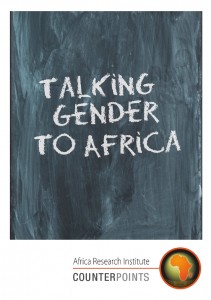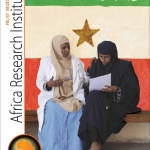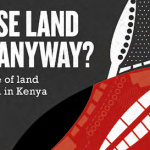Download the Full Counterpoint
International donors have sought to improve the social, political and economic position of women in Africa through an approach known as “gender”. This donor-driven strategy is failing. The jargon of gender programmes is ambiguous and easily misunderstood. It fosters inaction and lip service on the part of patriarchal African governments and civil servants. Gender has become the preserve of the educated elite. The voices of African women have been lost.
Nailed to a tree by a busy road in Kampala, the capital of Uganda, hangs a tattered picture depicting a pregnant woman bent double, sweeping the ground with a straw brush. She has a baby slung over her back. Next to her, a man lounges on a chair, his legs sprawled before him. He is drinking a bottle of beer, and grinning. The caption urges passers-by to “Help Empower Women”.
Women have become icons for poverty and oppression all over the developing world. Countless reports from development agencies will tell you that “poverty has a female face”, or women are “the face of malnutrition”. Nowhere is such stereotyping more prevalent, or misleading, than in Africa. The inequality and injustice customarily experienced by women in Africa are acute, and well-documented. But as mothers, workers, carers and keepers of the home, African women are the queens of multi-tasking.
International donors and aid organisations have promoted gender equality in all development policies and interventions, through a strategy referred to as “gender mainstreaming”. “Poverty reduction and gender equality are inextricably linked”,(1) declared President Ellen Johnson Sirleaf of Liberia, Africa’s first elected female head of state. Another familiar refrain is that equality between men and women is “smart economics”, which will lead to higher GDP growth and better development outcomes.
The term “Gender and Development” (GAD) emerged in the mid-1980s. Rooted in western feminism, it encapsulated a new approach to women’s unequal status in the developing world. The concept proposes that differences between men and women should not be viewed in biological terms, but by examining the social, political and economic relationships between sexes that underpin inequality.
In 1995, the gender and development approach – or “gender” for short – was formally endorsed by governments, donor organisations and aid agencies at the fourth UN World Conference on Women in Beijing, China. A strategy known as “gender mainstreaming” was devised by aid agencies to promote a gender perspective throughout government policy and donor programmes. In 2000, the third UN Millennium Development Goal reinforced the commitments made in Beijing by calling for the active promotion of “gender equality and the empowerment of women”.
In the aftermath of the Rwandan genocide in 1994, I oversaw an emergency project which ran health stations in a refugee camp in Goma, Zaire (now Democratic Republic of Congo). Since the mid-1990s, I have been employed as a gender consultant to major international development organisations, and have worked in more than a dozen countries in sub-Saharan Africa. My experience – in the field, and in government offices – has led me to believe that the gender approach to countering oppression of African women is failing.
The jargon of gender
The international development industry is saturated with institutional jargon. Reports published by United Nations agencies and bilateral donors are littered with references to “capacity-building workshops”, “stakeholder participation” and “cross-cutting issues”. Many in the industry argue that standardised terminology saves time otherwise wasted by having to explain what they mean. Such an attitude is illuminating. It pre-supposes that the principal target audience comprises fellow specialists – which is not always the case. It also assumes a common interpretation of the terminology. In my experience, the unrestrained use of jargon breeds confusion and encourages misunderstanding.
Gender has come to mean all things to all men – and women
Jargon is ubiquitous in “gender”. The gender lingua franca embraces terms ranging from the ambiguous – “gender responsiveness”, “gender integration”, “gender sensitisation” – to the downright absurd. I have been asked to “engender” development reports and government policies. Manuals with titles like Gender Analysis for Monitoring and Evaluation: The Engendered Logframe Approach abound.(2) Gender has come to mean all things to all men – and women. The word “gender” originally connoted the oppression of women by men but is now used to refer to women, women and men, or even women and children.
The strategy “gender mainstreaming” can mean anything from the integration of a “gender perspective” in aid policies and programmes, to empowering women through development. Yet these are very different concepts. Similarly, the important difference between promoting “women’s rights” and “gender equality” is consistently overlooked. Gender manuals often use these terms interchangeably on one page, only to draw a distinction between the two on another. “Gender empowerment” is routinely conflated with “women’s empowerment”.
Imprecise, ambiguous terminology developed by foreign donor organisations and aid agencies is poorly understood by those tasked with implementing gender policy in Africa – from government departments to the schoolroom and clinic. As Jackie Asiimwe, a Ugandan lawyer and women’s right advocate, succinctly put it to me, “the gender language becomes lost in translation – it has remained an academic exercise and people struggle with what it means”.(3)
It is unsurprising, given the widespread bewilderment caused by gender jargon, that the feminist, grassroots spirit that underpinned the original gender approach has dissipated. For example, sexual violence against women – an alarmingly common phenomenon in
Africa – has been repackaged as a sub-category of “gender-based violence” – a term which includes violence against men perpetrated by women. Such studied even-handedness, however well-intentioned, downplays – even obscures – the fact that the vast majority of victims of gender-based violence are female. It is commonplace for development agencies to refer to gender-based violence when they mean violence against women.
Ivory towers
On the face of it, African regional bodies, governments and women’s organisations have adopted the gender approach with enthusiasm. The African Union (AU) adopted a “Solemn Declaration on Gender Equality in Africa” in 2004, and has declared 2010-20 the “African Women’s Decade”. On the 100th International Women’s Day, in March 2011, a senior project manager with the New Partnership for Africa’s Development (NEPAD) announced that “Africa needs gender responsive development”.
The Beijing Platform for Action called for the establishment of “national gender machineries” to oversee gender mainstreaming. Donors have responded by providing support to under-resourced government ministries. External funding for development programmes has become conditional on the inclusion of “women’s empowerment” or “gender equality”. The Logical Framework Approach (LFA) – the development industry’s preferred planning and monitoring tool – specifies the need for “gender responsive” indicators purporting to measure a programme’s impact on gender equality. “Gender focal points”, often trained by development consultants, are charged with promoting gender mainstreaming in government organisations.
Gender is driven by donors, not by African governments. I have often been asked by African ministers and civil servants “can you do gender?” – as if I am being asked if I can ride a bicycle, or drive a car. Government officials frequently complain about a lack of resources for gender workshops, gender training and daily allowances. But privately, and just as frequently, they ask what “gender” really means. When I was asked to help the Malawian Ministry of Gender construct a National Gender Programme in 2004, a senior member of staff at the ministry told me “you know the language the donors want to hear – write the programme in that language”.
It is as if adoption of the correct jargon in government circles has become the end rather than the means
The multifarious language of gender is everywhere, requiring those involved with gender programmes to become experts in its interpretation and deployment. Advice about which universities in Europe offer the best courses for a Master’s degree in gender is eagerly sought. The irony is that many of those returning home from their gender studies in Europe are lured away from their former jobs in government by the higher salaries offered by international aid agencies. Meanwhile, government departments remain ill-equipped to interpret, devise or implement gender policies. Donors frequently complain about the lack of gender skills in government ministries. Funding is produced for more training, and the cycle continues.
Beyond the office walls of aid organisations and government ministries, few African women have heard of gender or are aware of its impact on their lives. Negligible effort, or resource, is expended in engaging African women in gender policy debates, or in attempting to reflect in policy their perspectives and priorities. Gender mainstreaming has been reduced to an exercise in “box-ticking”. On a number of occasions, when someone realised that the gender box had not been properly ticked, I have been asked to apply gender expertise retrospectively to donor-funded programmes. Jackie Asiimwe sums up this state of affairs by saying, “gender is the last spice you add to the pot, and ping you’ve mainstreamed gender. As long as the word appears, the policy is complete”.(4)
“All there on paper”
Gender jargon, devised and most actively promulgated by non-Africans, is a major cause of “policy evaporation” – in simple terms, the failure to translate words into deeds. While the lack of political will in Africa must not be overlooked, it is as if adoption of the correct jargon in government circles has become the end rather than the means. Gender has become the preserve of the educated elite.
National gender programmes may incorporate laudable – and specific – commitments to improve access for women and girls to education, justice and health services; to increase the representation of women in government; and to remove discriminatory legislation. But first and foremost will be a commitment to instil gender mainstreaming throughout government. By paying lip service to this objective, ministers and civil servants – mostly male – are provided with every opportunity to deflect perceived challenges to the patriarchal status quo or obstruct change.
In 2008, I was employed to assist the Uganda National Planning Authority (NPA), an autonomous agency of the Ministry of Finance, to incorporate gender ainstreaming into the National Development Plan (NDP) for 2010-15. After a series of consultations with gender experts in government, academia and civil society I set about articulating how the NDP might address factors inhibiting improvement in women’s lives. The country has the highest rate of adolescent pregnancy in sub-Saharan Africa. Ugandan women experience one of the highest incidences of domestic violence in the world. In the north of the country, vast numbers of women have been abducted, raped, mutilated and forced into prostitution during the 20 year conflict between government forces and the Lord’s Resistance Army. My text included specific measures for – among other things – increasing school attendance of girls, improving access to maternal and reproductive health care, targeting women in HIV prevention programmes, and improving access to justice for female victims of violence.
It is as if adoption of the correct jargon in government circles has become the end rather than the means
Most of the text I drew up was heavily diluted, obscured, or deleted altogether in Uganda’s draft NDP. As I sought to press my case, sentence by sentence, the chief drafter explained that gender had to compete for space with other “cross-cutting issues” like HIV/ AIDS and the environment. This was understandable – up to a point. The final document acknowledged the persistence and severity of gender inequality. But only a few of the NDP’s commitments “for promoting gender equality and transforming mind-set, attitudes, cultural practices, and perceptions”(5) relate specifically to women. Those that do are so vague or over-ambitious as to render their implementation implausible.
The Global Network of Women Peacebuilders (GNWP) commends Uganda for having “one of the most gender sensitive constitutions in the world, [and] many laws and policies in place to address gender imbalances and women’s empowerment”. But, in a 2010 report GNWP also observes that, “the challenge remains at the implementation level because many government bureaucrats do not really understand gender issues, [and] planners do not adequately provide for interventions … The result is that the well-meaning laws and policies largely remain on paper”.(6)
In 2010, I encountered more box-ticking when conducting a gender analysis of the multi-donor education programme in Kenya. The Ministry of Education has declared its intention to eliminate gender disparity throughout the education system. A Gender Unit has been set up to oversee implementation of this commitment. A Gender and Education Policy seeks to “promote equity and equality in education”. The policy’s first objective is to “mainstream gender” throughout the education sector. Other objectives include the need to “empower girls and boys, women and men on gender issues”, and to “ensure that all stakeholders in education, training and research are gender responsive”. But systems for evaluating success or failure in meeting objectives are non-existent. I could only rely on anecdotal evidence.
In the opinion of most people interviewed, one of the key achievements of the government’s gender strategy in education was the free distribution to schoolgirls of sanitary pads donated by Proctor & Gamble. A former senior official in the Ministry of Education, who preferred to remain anonymous, told me “gender – it’s all there
on paper, but when we come to implementing it we have problems. We live in a chauvinistic environment where our seniors, who are all men, do not want change”. On the ground, the same applies. Dr Leah Wanjama, director of the Gender and Affirmative Action Unit at Nairobi’s Kenyatta University, maintains that “teachers put the [gender] policy in their cabinets and lock it up. They have no idea what it is”.(7)
Since 2004, when I worked on Malawi’s National Gender Programme, legislation against domestic violence has been passed. But it is seldom enforced, and violence against women shows no sign of decreasing. The Land Act is under review, but any move towards facilitating the ownership of land by women is resisted by traditional elders and others. Initiatives to make the government budget take greater cognisance of women has proved as ephemeral as the term “gender” is incomprehensible to all but the initiated few in Malawi. A Gender Resource Centre established in the Ministry of Gender was closed down due to lack of use. At district level, many government officials are unaware that Malawi has a National Gender Programme.
Emma Kaliya, a women’s rights activist, blames a “persistent culture of patriarchy and slow attitude change” (8) for poor progress in empowering women in Malawi. Naomi Ngwira, an economist, asserts that the issue of women’s rights is in the hands of technocrats whose commitment is questionable because they lack political clout. “Gender equality is not a political issue in Malawi,” she says. “People don’t want to upset politicians, they have to be seen to work for the current leaders”.(9) For the obdurate and obstructive, gender jargon provides a plausible pretext for inaction – to the detriment of women.
An end in itself
The word “gender” has become nebulous, a cliché. In Africa, the gender approach – and gender mainstreaming – encourage generalisation of problems, within countries and across the continent. The ambiguities and abstractions of gender terminology foster inaction and lip service on the part of governments and civil servants. Fundamental societal change takes generations. But it is already apparent that the gender approach is not fit for purpose.
In Africa, the voices of women have been lost. The gender approach is not driven by a comprehensive understanding of the day-to-day realities of women’s lives, nor does it make adequate use of their wisdom and experience. It has become introspective, an end in itself rather than the means of advancing the social, economic and political position of women.
“Are we ready to stop applying a bandage to a wound that spans decades?” Jackie Asiimwe asked me. The answer must be affirmative. African women must again be placed centre-stage. Michelle Bachelet, executive director of the new agency UN Women, promised in her maiden speech to “think outside the box”.(10) The forcible dissolution of the language of gender, and recognition that African women – not international donors – must set the agenda, would be a promising start.
written by Henrietta Miers













